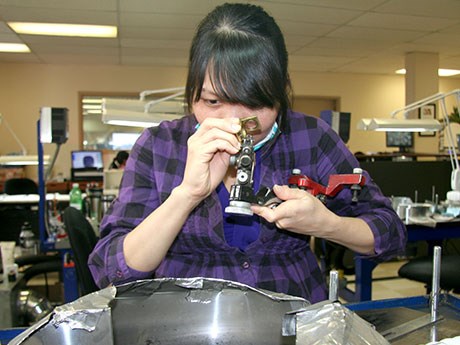Quality diamonds, skilled workforce and cutting-edge technology
The Ontario government’s resolve to leverage some downstream benefits from De Beers’ Victor Mine in the province’s James Bay Lowlands is paying off in spades…and diamonds.
An agreement to reserve 10 per cent of the value of Victor production for cutting and polishing in Ontario has put Sudbury on the map as North America’s largest centre of diamond cutting and polishing, according to Steve Beneteau, senior diamond advisor and chief gemologist with the Ministry of Northern Development and Mines.
The city’s Crossworks Manufacturing diamond factory opened in August 2009 with a complement of experienced cutters and polishers from the company’s factory in Vietnam. Importing a workforce was the only way to go given the absence of skilled diamond workers in Canada. Since then, several locals have been brought onboard and many of the Vietnamese workers have taken steps to bring their families to Sudbury and become Canadians themselves.
The factory currently employs approximately 30 people, but “by 2015, we should have a total of 50 employees,” said Beneteau.
That’s still a drop in the bucket compared to India, which boasts somewhere between 700,000 and 800,000 cutters, but it’s a start.
“We wanted to keep Ontario stones in the province to train people and have that resource locally,” said Beneteau. “We looked at the bigger picture. De Beers may not be here forever and if another mine comes on and we have the resource in Ontario, we can build a cutting and polishing industry.”
There are several other diamond cutting and polishing factories in Canada, including two Crossworks Manufacturing operations in Yellowknife and Vancouver and a factory in Prince Albert, Saskatchewan operated by Embee Diamond Technologies, but they are all a quarter to a third the size of the Sudbury operation.
A secure supply of quality diamonds, a skilled workforce and the use of cutting-edge technology account for the success of the Crossworks operation in Sudbury, said Beneteau.
“Between 80 and 85 per cent of diamonds recovered out of a typical kimberlite are industrial grade stones,” he noted. “With Victor, we have exactly the opposite. Between 85 and 90 per cent of the stones from Victor are gem quality. It’s the only deposit in the world like it.”
But the Crossworks factory in Sudbury doesn’t just cut and polish Victor stones. It also cuts and polishes stones from the Northwest Territories and Africa.
The work is meticulous and mentally fatiguing – certainly not everyone’s cup of tea. “If you screw up, you’re not just ruining a $5 lug nut. You’re potentially losing a half-million dollar stone,” said Beneteau.
Unlike the diamond cutting and polishing factories in India that use primitive technology, the Crossworks factory in Sudbury boasts the latest in automated bruting and laser cutting technology.
Diamonds from the De Beers Mine in Ontario are branded as Victor diamonds, certified by the Ontario government and individually laser marked with a unique identification number and a trillium, the official symbol of the government of Ontario. They are promoted as being highly sought-after for their natural beauty and provenance as well as their colour and clarity.
Assuring the integrity of the Victor brand, however, is a complex process. It starts with a visit to the mine site by Ministry staff roughly every five weeks to place a value on the mine’s production for royalty purposes.
The rough stones are then shipped to London, England, where De Beers’ marketing arm, the Diamond Trading Company, takes possession of them. Normally, they would be cleaned and aggregated with diamonds from other De Beers’ mines in Botswana, South Africa and elsewhere, “but when you aggregate, you lose the identity of the stones, so to make sure our stones aren’t lost in the mix, we go to London prior to the aggregation and we physically extract the 10 per cent we’re entitled to,” said Beneteau.
Ministry staff record the precise weight of every diamond selected and describe in “excruciating detail” several marker stones. The package is then offered for sale to Crossworks, sealed and shipped to Sudbury, “where we open it to make sure nothing has been tampered with,” said Beneteau. “We check the weights and the marker stones to make sure everything matches up. When we’re comfortable that the stones in front of us are the same ones we selected, we release them to the factory.”
The Victor diamond mine opened in 2008 and will be mined out in 2018, but De Beers has 16 other diamond bearing Kimberlite pipes on its property and hopes to have another deposit ready to go as Victor winds down.
Also promising is the U2 Kimberlite discovery by Metalex Ventures Ltd., 60 kilometres west of the Victor Mine. Earlier this year, Metalex Ventures chairman and celebrated diamond hunter Charles Fipke announced an earn-in agreement with Dundee Corporation for a four-stage investment of up to $51 million. The funds will be used to extend a winter road from Victor to the U2 discovery, extract a 10,000-ton bulk sample and undertake a feasibility study.
According to the company, “diamonds recovered from the U2 pipe are of exceptional quality with 88.8 per cent by weight of the +1.7mm diamonds being white and 1.1 per cent being coloured.”
With any luck, the Crossworks Manufacturing factory in Sudbury could be in business for many more years.


